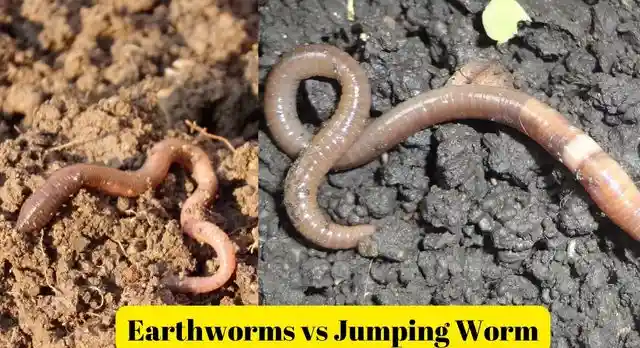Jumping Worms vs Earthworms: Exploring the Key Differences
When it comes to the world of soil-dwelling creatures, earthworms have long held the title of being the ultimate gardeners. Their underground work is essential for soil aeration and nutrient cycling, benefiting plant growth and ecosystem health. However, in recent years, a new contender has emerged – the jumping worm. Also known as the snake worm or crazy worm, this invasive species has been causing concern among gardeners and ecologists alike. In this article, we will delve into the significant differences between jumping worms and earthworms and explore the impact of these jumping worms on our ecosystems.
Jumping Worms: An Invasive Threat
Jumping worms (Amynthas spp.) are native to East Asia and were likely introduced to North America through the horticulture trade. Unlike traditional earthworms, jumping worms are voracious eaters, consuming organic matter at an alarming rate and leaving behind grainy, coffee-like soil granules. Their rapid feeding leads to the depletion of leaf litter on the forest floor, affecting the habitat for native plants and animals. Moreover, jumping worms can reproduce quickly through fragmentation, making them a challenging species to control once established in a new area.
Earthworms: Nature’s Gardeners
Earthworms, on the other hand, are a diverse group of organisms belonging to the class Oligochaeta. They come in various species, but the most common ones are Lumbricus terrestris and Eisenia fetida (red wigglers). Earthworms play a crucial role in the soil ecosystem, breaking down organic matter through their digestive processes. They create tunnels in the soil, enhancing drainage and aeration, which improves the overall soil structure. Furthermore, earthworm castings, also known as vermicompost, are rich in nutrients and serve as natural fertilizers for plants.
Jumping worms vs earthworm pictures

A Comparative Analysis: Jumping Worms vs. Earthworms
Let’s take a closer look at the significant differences between jumping worms and earthworms:
Behavior and Movement
| Characteristic | Jumping Worms | Earthworms |
|---|---|---|
| Movement | Thrashing and jumping | Crawling in an “S” shape |
| Burrowing behavior | Shallow burrowers | Deep burrowers |
| Surface activity | Active on the soil surface | Mostly active in the soil |
| Hiding during the day | Seek shade or hide underground | May surface during rain or at night |
Reproduction
Jumping worms reproduce differently compared to earthworms. While both are hermaphroditic (possessing both male and female reproductive organs), their mating and reproduction processes differ.
Jumping Worms:
- Reproduce through fragmentation.
- A broken piece of a jumping worm can grow into a new worm.
- Can produce several generations in a single year, contributing to their rapid spread.
Earthworms:
- Engage in copulation, exchanging sperm with other earthworms.
- Lay egg capsules containing multiple embryos.
- Reproduction rate is generally slower compared to jumping worms.
Feeding Habits
Jumping worms have distinctive feeding behaviors that set them apart from earthworms:
Jumping Worms:
- Consume large amounts of organic matter, including leaf litter and topsoil.
- Leave behind granular, dark castings resembling coffee grounds.
Earthworms:
- Feed on organic matter like decaying plant material and microorganisms.
- Produce nutrient-rich castings that are beneficial for soil fertility.
Environmental Impact
The arrival of jumping worms in North American ecosystems has raised concerns due to their potential impact:
Jumping Worms:
- Alter soil structure, leading to reduced water retention and increased erosion risk.
- Disrupt the natural balance of forest ecosystems by consuming the leaf litter needed for native plants and insects.
- May outcompete native earthworm species, further disrupting the soil ecosystem.
Earthworms:
- Generally considered beneficial for soil health and fertility in most ecosystems where they are native.
- Aid in plant growth through nutrient cycling and improved soil aeration.
Key Takeaway
While both jumping worms and earthworms belong to the same phylum Annelida, they differ significantly in their behavior, feeding habits, and environmental impact. Earthworms play a vital role in maintaining healthy soil ecosystems, while the invasive jumping worms pose a threat to native flora and fauna. As gardeners and stewards of the environment, it is essential to be aware of these differences and take measures to prevent the spread of jumping worms to protect our delicate ecosystems.
In conclusion, let’s continue to appreciate and support the work of our earthworm allies while remaining vigilant against the potential harm of invasive species like jumping worms. By understanding the nuances between these soil-dwelling creatures, we can make informed decisions to ensure a sustainable and thriving environment for generations to come.
How do you tell if a worm is a jumping worm?
You can recognize jumping worms by the way they move. They move quickly and might seem like they are jumping or thrashing around. When you see them, they will likely be on the surface of the soil, and they may look more rigid compared to regular earthworms. Their color can vary, but some jumping worms have a grayish or reddish-brown body.
What is the difference between earthworms and jumping worms?
Earthworms and jumping worms are both types of worms, but they have some important differences. Earthworms move in a wiggling “S” shape and burrow deep into the soil. They eat decaying plant material and help make the soil healthier for plants. On the other hand, jumping worms move more like they are jumping or thrashing around. They stay closer to the soil surface and eat a lot of organic matter, like leaves. Jumping worms can be more harmful to the environment compared to earthworms.
